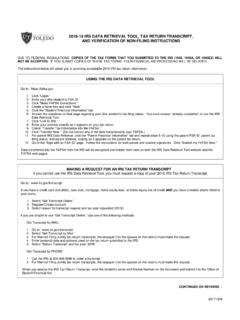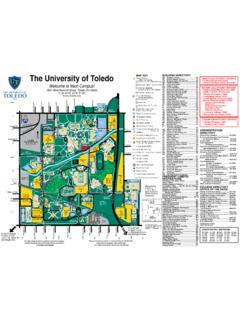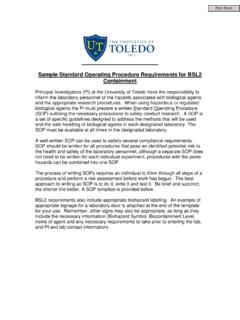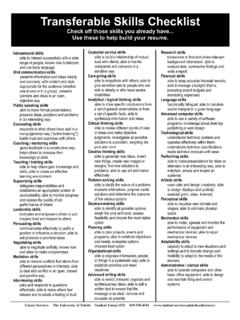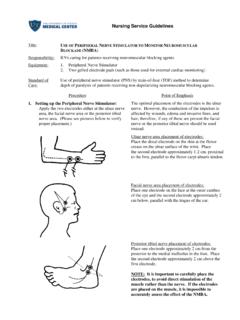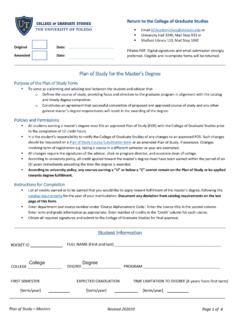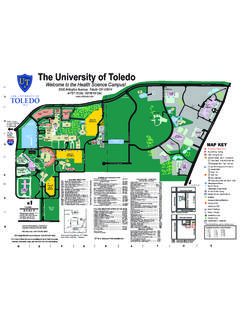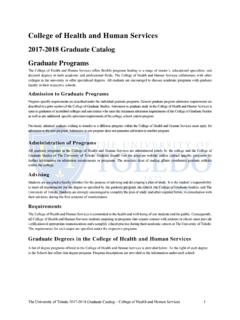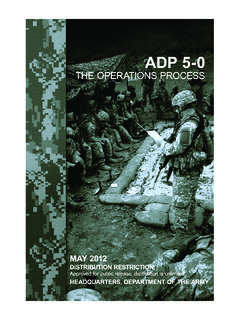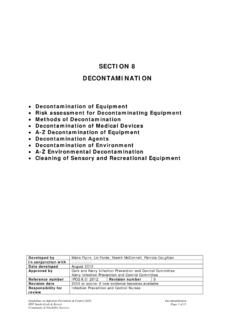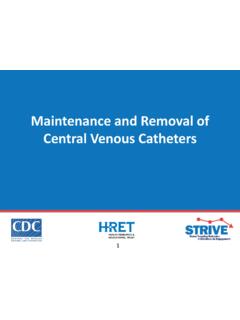Transcription of FY2022 Infection Prevention and Control Plan w IC Risk ...
1 1 Infection Prevention and Control Plan FY2022 (for CY 2021) I. Introduction The Infection Prevention and Control (IPC) Plan is a description of the multidisciplinary, systematic, coordinated approach developed by the University of Toledo Medical Center (UTMC) to reduce the risks of acquiring and transmitting infections among patients, employees, physicians and other licensed independent practitioners (LIP), contract employees, volunteers, students, and visitors. II. Mission The mission of the UTMC IPC Program is to support UTMC by fostering a culture of patient safety, and by developing and implementing evidence-based strategies that reduce the risk of acquiring and transmitting infections through education, collaboration, and research.
2 III. Authority Statement The Infection Control (IC) Committee is a medical staff committee and shall have the authority under the medical staff bylaws to institute appropriate Control measures when and if an infectious hazard is identified, or anticipated, that may affect any patient, employee, student, LIP, contract employee, volunteer, faculty, and/or visitor. The chairperson and the Infection Prevention staff shall be notified of the potential issue and shall confer with committee members as necessary to institute appropriate Control measures. In their absence, an appropriate director or administrator shall assume responsibility for instituting Control measures. The IC committee also has the authority for routine identification and analysis of the incidence and cause of infectious diseases within the hospital and shall develop and implement processes for the surveillance, Prevention , and Control of infectious disease.
3 IV. Program Goals The 2021 overarching goals for the IPC Program are aimed at improving patient safety by eliminating hospital-acquired infections: a. Eliminate surgical site infections b. Eliminate device-related infections c. Eliminate transmission of infections d. Reducing risks of disease transmission related SARS-CoV-2 V. Plan Components Several considerations are made to guide the activities of the program, including internal and external requirements and activities related to healthcare. Careful consideration is made based on internal and external surveillance activities from the preceding year. An IPC Risk Assessment for UTMC is completed at least annually to 2 inform and establish program priorities. The IPC Plan is based upon the most current risk assessment (See attached 2021 Infection Control Plan Risk Assessment).
4 VI. Surveillance Activities A. The activities related to Infection Prevention surveillance are based on the risk assessment of populations served at UTMC hospital, clinics, high risk/high volume indicators, Centers for Disease Control and Prevention (CDC) definitions of infections, and facility needs based on the annual assessment. County, state, and CDC emerging and reemerging disease reports, as well as reported outbreaks are taken into consideration when planning surveillance activities. B. Surveillance and Prevention activities are designed to coordinate processes with the related patient care support departments/services ( , Family Medicine Clinic, Sterile Processing, Environmental Services, Linen and Laundry Services, Microbiology, Nursing Services, Environmental Health and Radiation, and Safety Department).
5 C. Priority-directed, targeted surveillance is utilized and related to the scope of service. High volume and/or high frequency infectious complications, reoccurrence of previous Infection Prevention and Control issues, and issues that have potential for significant adverse patient outcomes are included in the surveillance process. D. Utilizing the surveillance data-mining system, the IPC staff obtain laboratory relevant culture information from the microbiology system to assist in determining whether or not an Infection has occurred and whether or not the Infection was healthcare-acquired. In addition, the daily inpatient census is reviewed for current or potential Infection -related issues. Methods for determining presence and classification of Infection are based on national guidelines and definitions published by the CDC/ National Health Safety Network (NHSN) program.
6 Reports are generated by rate, count and NHSN standardized Infection ratio (SIR) using national benchmarks. E. The Occupational Health Department uses the Occupational Health Manager system for tracking bloodborne pathogen exposures and employee vaccination status. VII. Selected IPC Goals and Objective for FY 2022 (CY 2021) A. Eliminate surgical site infections: a. All identified surgical site infections (SSIs) are reviewed for evidence of a hospital- acquired Infection and trends. Specific attention is paid to the following, with reporting of these surgical site infections into the NHSN Database: i. Kidney transplant 2021 objective: a) Decrease SIR below 2019 - CDC Healthcare-associated Infection (HAI) Progress Report of a. Transplantation of kidney ii.
7 Spine surgeries 2021 objective: 3 a) Decrease SIR below 2019 - CDC HAI Progress Report of a. Fusion or refusions i. Immobilization of spinal column iii. Colon surgeries 2021 objective: a) Maintain SIR below CMS established threshold of a. Incision, resection, or anastomosis of the large intestine iv. Abdominal Hysterectomy surgeries (including those done by laparoscope) 2021 objective: a) Maintain SIR below CMS established threshold of a. Abdominal hysterectomy including that done by laparoscope v. Knee prosthesis surgeries 2021 objective: a) Decrease SIR below 2019 - CDC HAI Progress Report of a. Arthroplasty of the knee vi. Hip prosthesis surgeries 2021 objective: a) Decrease SIR below 2019 - CDC HAI Progress Report of a. Arthroplasty of the hip vii.
8 Other cases classified as clean 2021 objective: a) Decrease rate to less than 2020-UTMC clean case rate of procedures B. Eliminate Hospital-acquired Device-related Infections a. Ventilator-associated events (VAE): i. Definition: deterioration in respiratory status after a period of stability or improvement on the ventilator, evidence of Infection or inflammation, and laboratory evidence of respiratory Infection a) VAE 2021 objective decrease SIR below 2019 CDC HAI Progress Report of b) Ventilator-associated condition (VAC) 2021 objective 10% reduction from 2020 c) IVAC Plus: Infection -related ventilator-associated complication (IVAC) and Possible ventilator-associated pneumonia (PVAP) combined 2021 objective 10% reduction from 2020 b.
9 Central line-associated blood stream infections (CLABSI) 2021 objective maintain SIR below CMS established threshold of 0. c. Catheter-associated urinary tract infections (CAUTI) 2021 objective maintain SIR below CMS established threshold of C. Eliminate Transmission of Infections a. Assist in maintaining UTMC goal for mandatory vaccination of all healthcare workers for the 2020-2021 and 2021-2022 seasons: i. Provide vaccine free-of-charge at various locations and times to 100% of all healthcare workers on the UTMC Health Science Campus. This includes employees, faculty, LIPs, volunteers, contract employees, vendors and students ii. Personnel vaccinated will be identifiable by badge stickers iii. Personnel that received an approved exemption for current year will be required to wear a surgical mask according to manufacture 4 recommendations while performing patient care and while in patient care areas during the designated flu season iv.
10 Exemptions will be allowed, in accordance with the hospital s immunization policy, for those persons with valid medical or religious exemptions as determined by the exemption committee v. Record keeping will be tracked through Occupational Health electronic records system. Infection Prevention staff or other designees will report all vaccination data to CDC/NHSN as required vi. Incremental influenza vaccination rate goals established in 2014 2015 season, consistent with achieving the 90% rate established by The Joint Commission national influenza vaccination initiative for 2021 are: a) 2014 2015 = 53% b) 2015 2016 = 65% c) 2016 2017 = 75% d) 2017 2018 = 80% e) 2018 2019 = 90% f) 2019 2020 = 90% g) 2020 2021 = 90% b. Assist in increasing COVID-19 vaccinations for all UTMC healthcare workers as vaccination criteria expands according to Ohio Dept.
